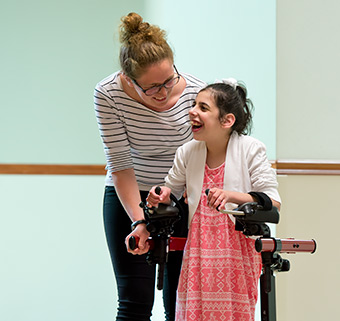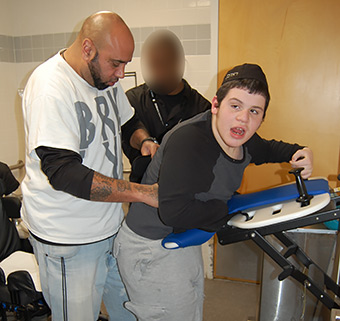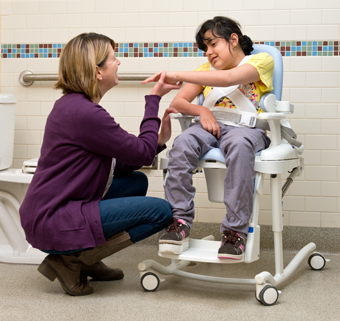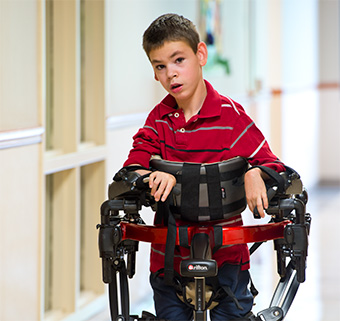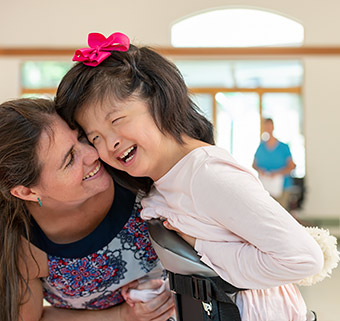Linda Bidabe, 1945 - 2017
Founder, visionary, advocate and friend
| November 2017Heroes and social giants belong to other times and other places. We see the well- known images of Gandhi, Mother Teresa, Nelson Mandela, Oscar Schindler, and we know where they lived, what they did, and why we remember them. We know who the famous people are.
 A lesser known woman, but one who is no less a hero is Linda Bidabe. Those who know her know that she developed movement science concepts ahead of her time, and broke wide open the opportunities available to the most severely involved individuals. Grit and gumption transformed Linda from a reliable Kern County Schools employee to a maverick special education teacher determined to give her children a chance to get off their bean-bag chairs. Flying in the face of conventionally-taught therapeutic practices, her brain-child, MOVE™ (Mobility Opportunities Via Education), developed into a ground-breaking curriculum that has changed thousands of lives.
A lesser known woman, but one who is no less a hero is Linda Bidabe. Those who know her know that she developed movement science concepts ahead of her time, and broke wide open the opportunities available to the most severely involved individuals. Grit and gumption transformed Linda from a reliable Kern County Schools employee to a maverick special education teacher determined to give her children a chance to get off their bean-bag chairs. Flying in the face of conventionally-taught therapeutic practices, her brain-child, MOVE™ (Mobility Opportunities Via Education), developed into a ground-breaking curriculum that has changed thousands of lives.
So while there may be some who question placing Linda in such rarified company of international humanitarian heroes, among those of us who knew her and watched her at work it is no stretch at all. News of her passing prompted a flurry of memories within the Rifton family, including an exchange of emails with a friend, Chris Voll, now living half-way around the world in Australia, who in the 1990s co-authored Linda’s memoirs, No Ordinary Move. We talked about her influence and charisma, and about her legacy. Chris wrote:
The year I spent working with Linda to write her memoir was one I’ll never forget. Together we retraced her journey from Midwest farmer’s daughter to pioneering educator. Along the way I was privileged to meet Linda’s family and some of her childhood friends; to explore the world of 1950s Kansas as well as her difficult yet formative relationship with her father; to hear stories of children warehoused as “beanbag kids” – and of Linda’s outrage when she learned no one was advocating for them. Of her determination that things don’t have to stay as they are, just because “that’s the way it’s always been.”
Linda was that rare combination of immense intellect and immense heart. I’m not sure can’t was in her vocabulary. Whether diving into an ice-cold river to save her sister from drowning, or teaching herself computer programming so she could found an enterprise designing software for children with learning disabilities, Linda tenaciously tackled problems and went about solving them. Put simply, she was born to help other people. That’s who she was, and part of her legacy is the challenge to the rest of us to do the same.
The Rifton team first met Linda in 1988 at the Blair School in Bakersfield, California, where she was implementing her visionary ideas using devices made in a garage out of bent pipe, foam and duct tape. Recognition was immediate. “This is the future of developmental therapy,” declared a Rifton administrator.
 As a young member of the Rifton family, I knew Linda by sight, I had heard her speak, and I knew what she was about. She would visit the Rifton locations when she was on the East Coast, and talk to us about the life-changing possibilities opening up for kiddos who had until now been consigned to floor mats. She described her own surprise at the profound changes in the lives of the children enrolled in curriculum. She was an evangelist, bringing incredibly good news to families and educators alike, and we were all believers.
As a young member of the Rifton family, I knew Linda by sight, I had heard her speak, and I knew what she was about. She would visit the Rifton locations when she was on the East Coast, and talk to us about the life-changing possibilities opening up for kiddos who had until now been consigned to floor mats. She described her own surprise at the profound changes in the lives of the children enrolled in curriculum. She was an evangelist, bringing incredibly good news to families and educators alike, and we were all believers.
In 1992 I moved with my husband and children to Germany, where we imported Rifton devices and sold them into schools and facilities. Forward thinkers, the disability professionals were eager to implement the curriculum that used our products. Linda came over to conduct trainings, and my husband and I set up and managed her tours, typically eight to ten days of seminars and workshops in strategic locations, attended by therapists, healthcare workers, teachers and parents. A Kansas-to-California girl to the core, she jolted the Nordic sensibilities of her German audiences, but it didn’t take long until they were eating from her hand and clamoring for more.
Linda’s arrivals in Germany were highly anticipated, even the one that occurred three weeks after the birth of our third child. She stayed with us when not on the road, and we spent many hours together, Linda in the rocking chair with my newborn in her arms, singing to her: Michelle, ma belle…. Those were beautiful moments, and Linda and I talked about anything and everything as she relaxed and I healed. Over the years, Linda always asked about her, and neither of us imagined that one day this child would dream of becoming a physical therapist herself. My last contact with Linda was an email letting her know that her ‘baby’ had been accepted into Duke’s DPT program.
 Several years later, back in New York, we continued to participate in MOVE events and trainings, Model Site inaugurations, and hosted Linda in our home and on the road. Of course, I was only one among hundreds who benefited from Linda’s ability to make whoever she was with feel the entirety of her attention and focus, compassion and friendship – indeed, her gift. Whether she was with me in the sunlight of my home, or connecting with a parent and child in front of a bank of intent therapists and clinicians, her unwavering focus and commitment to her dream was a force of nature.
Several years later, back in New York, we continued to participate in MOVE events and trainings, Model Site inaugurations, and hosted Linda in our home and on the road. Of course, I was only one among hundreds who benefited from Linda’s ability to make whoever she was with feel the entirety of her attention and focus, compassion and friendship – indeed, her gift. Whether she was with me in the sunlight of my home, or connecting with a parent and child in front of a bank of intent therapists and clinicians, her unwavering focus and commitment to her dream was a force of nature.
Linda had the humility to know when to hand over the reins to new visionaries with new energy. She had some years of retirement, enjoyed her grandchildren, relaxed and rested. Cancer took her quickly; her passing on October 25th was unexpected for all of us. But her dream is in good hands, and will not die. Her legacy is monumental and personal: monumental because she has changed the paradigms of an entire clinical discipline, and personal because so many children have gained freedom of movement through her visionary ideas.
There are memorial sites for national and world heroes: generals, saints, warriors, athletes, writers. But what about someone like Linda, who worked largely in obscurity, unheralded, changing the lives of those with no voice, no lobby? There should be a place, somewhere hallowed, an avenue of trees perhaps – living monuments – where Linda’s life-work of saving thousands of children from the prison of immobility can be memorialized. Until we find the right place, it will remain, no less hallowed, in our hearts.


